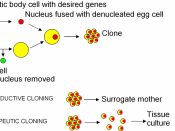The theory of being able to make a genetic copy (a clone) of another animal has been around for quite a while. In this section as the title reads I will show the history of cloning.
400 million years B. C.- Plants have been cloning themselves since not to long (as far as the Earth is concerned) after their introduction to our planet. They send out runners that create an identical copy of the parent plant.
1938- Hans Spermann, of Germany, envisions what he calls the "fantastical experiment". He suggests taking the nucleus from a cell in the late-stage embryo and transplanting that nucleus into an egg.
1952- Scientists Robert Briggs and T.J. King use a pipette to suck the nucleus from the cell of an advanced frog embryo, they then add it to a frog egg. The egg didn't develop.
1970- John Gurdon tries the same experiment with the same procedure.
The eggs developed into tadpoles but died after they were ready to begin feeding. He later showed that transplanted nuclei revert to an embryonic state.
1973- Ian Wilmut just finishes his doctorate at Cambridge University when he produces the first calf born from a frozen embryo. Cows only give birth to five to ten calves in a lifetime. By taking frozen embryos produced by cows that provide the best meat or milk then transferring that to surrogate mother it allows cattle farmers increase the quality of their herd.
Mid to late 1970's- Scientists cut down small forests publishing research papers arguing the ethics of cloning and if it can be done. While they do this other researches around the world are actually investigating if it can be done.
1981- Karl Illmensee and Peter Hoppe report that they clone normal mice and embryo cells. It is later found to...



Very good
Human cloning is big issue now a days and its a very helpful essay in order to get the history of cloning and its effect
0 out of 0 people found this comment useful.